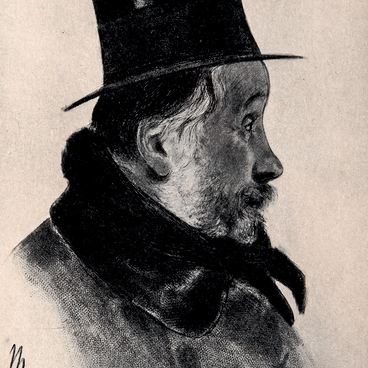This watercolor painting belonged to YUlia Eisenstein née KonEtskaya, Sergei Eisenstein’s mother, and hung in her room at her dAcha (summer house) in KrAtovo. Experts have not yet established the authorship of the painting, but assume that it was painted by a professional artist. Most likely, it was created in the early 20th century.
Floral motifs were one of Yulia Eisenstein’s favorites. On the needlework table in the PetrogrAd exposition area, there is a Venetian candlestick with a glass bouquet that Yulia Eisenstein brought from her travels and the grey canvas tablecloth she embroidered with little wreaths. In his memoirs, Sergei Eisenstein compared the interior of his grandmother’s (Iraida Konetskaya) bedroom with Picasso’s blue and pink periods: ‘I remember, when I was a little boy, grandmother’s bedroom was all blue. Blue velvet on low chairs and long blue drapery. Did granny have a blue period? Did Mommy have pink one? Now the drapery and furniture from mom’s boudoir live out their age at her datcha. The wreaths are barely seen. (…) I remember very well how I was hectically monitoring the stock exchange reports among the furnishings of this white-pink boudoir with wreaths, when mom decided to play on the stock exchange with a little spare money…’
Sergei Eisenstein had a very difficult relationship with his mother, as the director himself recalled, he treated her with ‘cautious filial affection.’ They loved each other, Eisenstein had a hard time with his parents' breakup in 1909. While they had close relationship throughout his life, he was often bitterly aware that his mother did not really understand him, although she was vainly proud of her son’s world fame. Nevertheless, he took care of his mother all these years. Having received an apartment in a house on Potylikha Street in 1935, he made sure that Yulia Eisenstein got his room in the communalka (shared apartment) on Chistye Prudy, giving his Leningrad apartment to Sergei Vasilyev, one of the directors of Chapaev.
Floral motifs were one of Yulia Eisenstein’s favorites. On the needlework table in the PetrogrAd exposition area, there is a Venetian candlestick with a glass bouquet that Yulia Eisenstein brought from her travels and the grey canvas tablecloth she embroidered with little wreaths. In his memoirs, Sergei Eisenstein compared the interior of his grandmother’s (Iraida Konetskaya) bedroom with Picasso’s blue and pink periods: ‘I remember, when I was a little boy, grandmother’s bedroom was all blue. Blue velvet on low chairs and long blue drapery. Did granny have a blue period? Did Mommy have pink one? Now the drapery and furniture from mom’s boudoir live out their age at her datcha. The wreaths are barely seen. (…) I remember very well how I was hectically monitoring the stock exchange reports among the furnishings of this white-pink boudoir with wreaths, when mom decided to play on the stock exchange with a little spare money…’
Sergei Eisenstein had a very difficult relationship with his mother, as the director himself recalled, he treated her with ‘cautious filial affection.’ They loved each other, Eisenstein had a hard time with his parents' breakup in 1909. While they had close relationship throughout his life, he was often bitterly aware that his mother did not really understand him, although she was vainly proud of her son’s world fame. Nevertheless, he took care of his mother all these years. Having received an apartment in a house on Potylikha Street in 1935, he made sure that Yulia Eisenstein got his room in the communalka (shared apartment) on Chistye Prudy, giving his Leningrad apartment to Sergei Vasilyev, one of the directors of Chapaev.




